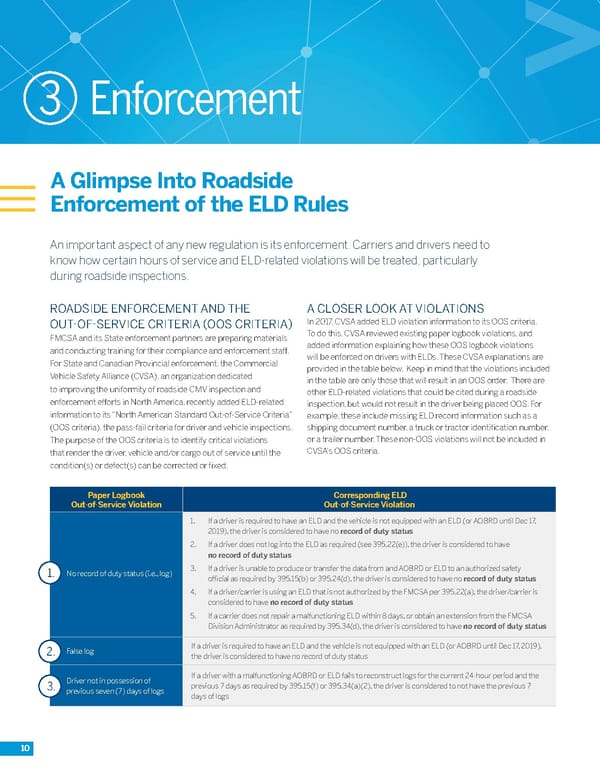3 Enforcement A Glimpse Into Roadside Enforcement of the ELD Rules An important aspect of any new regulation is its enforcement. Carriers and drivers need to know how certain hours of service and ELD-related violations will be treated, particularly during roadside inspections. ROADSIDE ENFORCEMENT AND THE A CLOSER LOOK AT VIOLATIONS OUT-OF-SERVICE CRITERIA (OOS CRITERIA) In 2017, CVSA added ELD violation information to its OOS criteria. FMCSA and its State enforcement partners are preparing materials To do this, CVSA reviewed existing paper logbook violations, and and conducting training for their compliance and enforcement staff. added information explaining how these OOS logbook violations For State and Canadian Provincial enforcement, the Commercial will be enforced on drivers with ELDs. These CVSA explanations are provided in the table below. Keep in mind that the violations included Vehicle Safety Alliance (CVSA), an organization dedicated in the table are only those that will result in an OOS order. There are to improving the uniformity of roadside CMV inspection and other ELD-related violations that could be cited during a roadside enforcement efforts in North America, recently added ELD-related inspection, but would not result in the driver being placed OOS. For information to its “North American Standard Out-of-Service Criteria” example, these include missing ELD record information such as a (OOS criteria), the pass-fail criteria for driver and vehicle inspections. shipping document number, a truck or tractor identification number, The purpose of the OOS criteria is to identify critical violations or a trailer number. These non-OOS violations will not be included in that render the driver, vehicle and/or cargo out of service until the CVSA’s OOS criteria. condition(s) or defect(s) can be corrected or fixed. Paper Logbook Corresponding ELD Out-of-Service Violation Out-of-Service Violation 1. If a driver is required to have an ELD and the vehicle is not equipped with an ELD (or AOBRD until Dec 17, 2019), the driver is considered to have no record of duty status 2. If a driver does not log into the ELD as required (see 395.22(e)), the driver is considered to have no record of duty status 1. No record of duty status (i.e., log) 3. If a driver is unable to produce or transfer the data from and AOBRD or ELD to an authorized safety official as required by 395.15(b) or 395.24(d), the driver is considered to have no record of duty status 4. If a driver/carrier is using an ELD that is not authorized by the FMCSA per 395.22(a), the driver/carrier is considered to have no record of duty status 5. If a carrier does not repair a malfunctioning ELD within 8 days, or obtain an extension from the FMCSA Division Administrator as required by 395.34(d), the driver is considered to have no record of duty status 2. False log If a driver is required to have an ELD and the vehicle is not equipped with an ELD (or AOBRD until Dec 17, 2019), the driver is considered to have no record of duty status Driver not in possession of If a driver with a malfunctioning AOBRD or ELD fails to reconstruct logs for the current 24-hour period and the 3. previous seven (7) days of logs previous 7 days as required by 395.15(f) or 395.34(a)(2), the driver is considered to not have the previous 7 days of logs 10
 Roadmap to the ELD Mandate Page 9 Page 11
Roadmap to the ELD Mandate Page 9 Page 11